Laptop Graphics Face Off: Diablo III Performance
by Jarred Walton on May 26, 2012 4:25 AM ESTDetailed FRAPS Runs and Closing Thoughts
For those of you that want a different view of the gaming action, we’ve selected the highest quality but still playable result for each GPU. In general, that means we wanted average frame rates of 25 or higher, with minimum frame rates always above 15 FPS. Obviously you could tweak settings in other ways and still get playable results (e.g. by dropping the resolution, you might be able to run our Enthusiast settings at 1366x768 instead of Mainstream 1600x900), but we’ve stuck with our three basic categories for the following charts. We’ve ordered them in terms of increasing performance/quality.
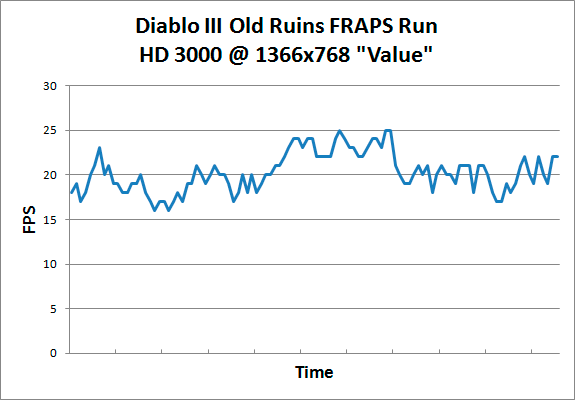
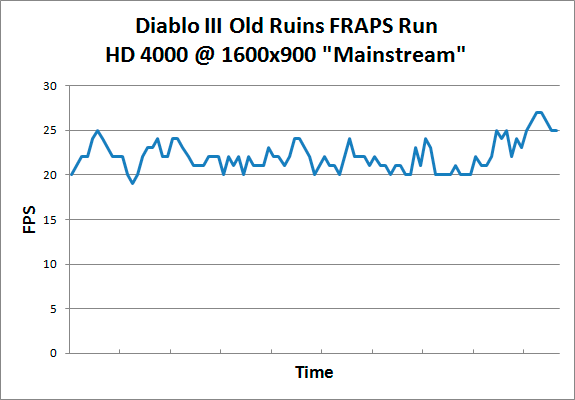
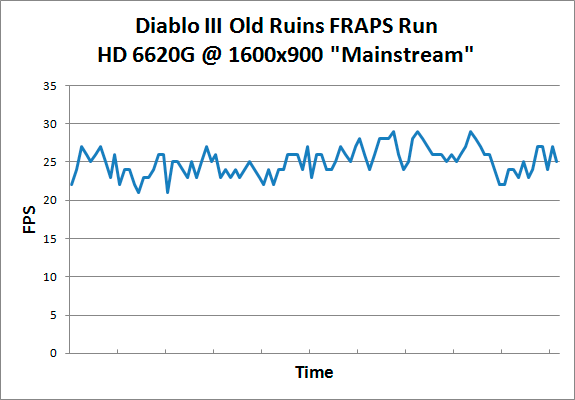

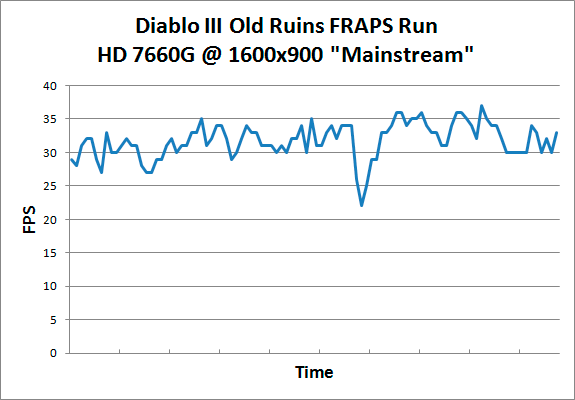

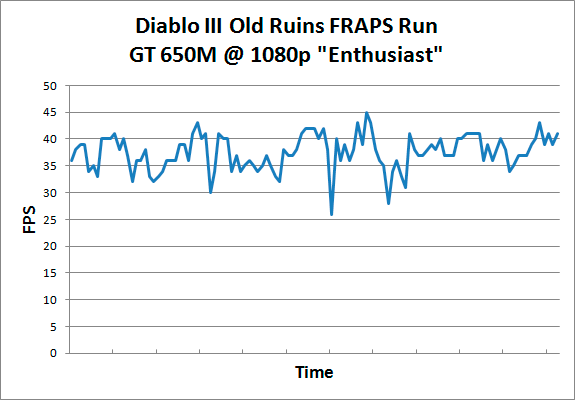
Given what we’ve said already, your best results will generally come by keeping minimum frame rates above 20. Assuming there are other segments of the game that will be more taxing than our benchmark sequence, you might still drop into the upper teens, but as long as you’re above 15 FPS you shouldn’t “lose sync”. Even at our Value settings, HD 3000 is already dangerously close to dropping below 15 FPS at times; you might have to give up on Shadows altogether to get acceptable performance. HD 4000 at our Mainstream settings ends up staying above 20 FPS for the most part but rarely gets above 25 FPS; by comparison, Llano’s HD 6620G ranges from around 22 FPS to nearly 30 FPS. For a smoother experience, though, you’ll still want 30 FPS or more, and that’s where the HD 6630M and Trinity’s HD 7660G fall, with Trinity averaging just slightly better performance despite one large dip to the low 20s.
As shown in our earlier charts, the real winner in terms of gaming performance looks like NVIDIA, though the use of Ivy Bridge CPUs for our two fastest test laptops leaves room for debate. The Acer doesn't appear to have any real issues with throttling in this game, however, despite my earlier fears; it looks like Diablo III (at least early on) just doesn't tax the CPU enough to routinely need more than a moderate 1.2-1.6GHz on the i5-2410M. The 15~20% performance advantage of the N56VM over the 3830TG instead comes from a higher clocked GPU, despite earlier indications that the opposite was the case.
Closing Thoughts
Wrapping up, while Diablo III isn’t the most demanding new release, it can still bring basic laptops to their knees. Unfortunately, unlike desktops it’s often not possible (or at least not practical) to upgrade a laptop’s graphics capabilities. I’ve had a couple friends ask for help with running Diablo III on their old Core 2 Duo laptops, and they’re basically out of luck unless they want to purchase a new system. That’s something we’ve tried to explain in our laptop reviews, and Diablo III drives the point home: buying at the bottom of the barrel in terms of GPU capabilities may not matter for you right now, but kids and/or future applications may eventually make your IGP-only laptop insufficient.
In the case of Diablo III, even a moderate HD 3650 or GT 330M should still be able to handle the game in single player on Normal difficulty, but IGP solutions from two or more years back are likely going to come up short. Naturally, anything faster than the GPUs we’re testing here will allow you to increase details/resolution, and it’s nice to see “mainstream” mobile GPUs like the GT 540M/GT 630M able to handle 1080p gaming for a change.
And again, in case you missed it, the later stages of the game, particularly on Hell difficulty level, are said to be quite a bit more strenuous. If you're the type of player that intends to defeat Diablo not once but three or more times at increasingly difficult settings, our results from early in the game are probably not representative of what you'll experience later. Performance does appear to stay relatively consistent among the various GPUs, though, so if you take half of our performance results as a baseline of what to expect, you're probably not far off the mark.










87 Comments
View All Comments
JarredWalton - Sunday, May 27, 2012 - link
And funny enough, after additional investigation, the issue isn't throttling on the Acer but rather a higher clock on the GT 630M compared to the GT 540M. NVIDIA's updated specs page for the 630M lists 800MHz as the clock, but oddly their control panel is only reporting 475MHz on the ASUS. According to GPU-Z's Sensors tab, however, it really is running an ~800MHz core clock (1600MHz shaders), which accounts for the higher performance compared to the 672MHz GT 540M. I've updated the text in the article to explain this.ananduser - Saturday, May 26, 2012 - link
Suddenly those fancy expensive ultrabooks(Apple or otherwise) seem like extremely poor deals for tech enthusiasts. Then again they were always aimed at bloggers.DanNeely - Saturday, May 26, 2012 - link
... and enthusiasts who want an ultra portable that's a PC not a fondleslab, and which is faster than an atom.ananduser - Sunday, May 27, 2012 - link
No offense, enthusiasts(in the real sense of the word) are always more extreme than your average MBA wielding blogger. If they wanted something light they would spare no expense and would have gone with a VaioZ, or some crazy Japanese Fujitsu that is lithium made, or a moded Sony UX. PC hardware enthusiasm has nothing to do with Apple commodities that try to be as "safe" as possible.Impulses - Monday, May 28, 2012 - link
Suddenly? They were never marketed as gaming rigs, most don't even have dGPUs and Diablo 3 isn't even one of the 5 most demanding games this year. I dunno what you're getting at, ultrabooks are still great for the propose they're meant for. Can you get just as much done with an uglier/thicker/heavier $700 laptop? Sure, you might even get a dedicated GPU to go along with it... They're serving entirely different markets tho.ananduser - Monday, May 28, 2012 - link
Which is why I mentioned tech enthusiasts in my original comment. There's nothing that I dispute from your enumeration.futurepastnow - Saturday, May 26, 2012 - link
Or, perhaps I should say, a concern. You increase the detail setting and the resolution together.What about 1366x768 at high detail? Or 1920x1080 at low detail?
JarredWalton - Saturday, May 26, 2012 - link
I have to stick to a subset of the possible resolution/detail settings or I'd be testing a single game 24/7 for a week. I've already spent probably 20 hours benchmarking Diablo III, and let me tell you: running the same three minute sequence at least a dozen times per laptop gets to be mighty damn tedious. I did run tests at some other settings, which I commented on I believe, but here's a bit more detail.For example, on the N56VM, 1080p with all settings maxed but Shadow Quality set to Low results in performance of 20.1 FPS/18.5 FPS for our test sequences -- so that one setting boosted performance by over 50% compared to having all settings at High/Max. What's more, I also tested at max detail 1080p but with Shadow Quality set to Off, and the scores are 27.1/24.8 -- another 35% improvement over Low shadows. Everything else combined (e.g. 1080p but all other settings at low) only accounts for probably 20%. I could test that as well if you really want, but I have other things to do right now.
futurepastnow - Saturday, May 26, 2012 - link
I'm mostly thinking that a large majority of laptops sold, even now, have 1366x768 displays. It looks like all of the non-Intel laptops handle playable framerates with low detail at that resolution, so I'm curious how that performance falls as the detail goes up.In particular, can Llano and Trinity handle high detail at 1366x768? They are (or will be) sold in budget laptops that won't get high-res screens.
However, I understand the time constraints your working under. Thanks for the comparison, anyway.
kyuu - Saturday, May 26, 2012 - link
I agree with this. I understand time constraints, but honestly, the paradigm that's being followed here (and with a lot of reviews) is simply not representative of real-world usage. It's not the case that people play with low details at low resolutions and high details at high resolutions. *Especially* when you're dealing with laptops. Generally, you're going to have the resolution at the display's native resolution, and going to work with the settings from there.In any case, the article is still appreciated, and it's possible, at least, to make an educated guess at how the game will run at various resolutions and settings based on the presented info. Definitely going to grab myself a nice Trinity-powered laptop soon as one meeting my desired specs comes out.
Also, yet again we see that HD4000 does not match Llano, let alone exceed it, as I've seen some people spreading around.